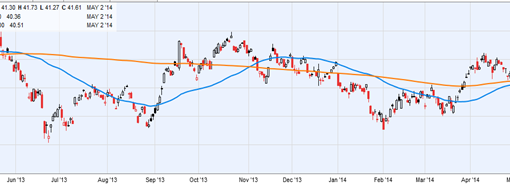The S&P 500 Index (SPX) closed the month of July in negative territory with a 1.5% decline, compared to the end of the previous month. In the last week of July, the S&P 500 fell 2.7 percent to 1,925, in its worst weekly performance in two years.
In July, there was intensifying geopolitical risks in the Middle East and Ukraine, a bond default in Argentina and increased volatility in the markets.
On the economic front, the Federal Reserve, despite remaining dovish about the state of the economy, announced that it would scale back its purchases of mortgage and Treasury bonds to $25 billion a month and delivered a modestly positive assessment of the economy.
The US economy expanded by 4% in the second quarter of 2014, which was above the expectations of most analysts. The strong GDP growth, coupled with more upbeat inflation expectations, increased the speculation that Fed may raise interest rates sooner than expected.
The strong growth in the second quarter was no surprise. In my July monthly report, I predicted US economic growth would advance by 4% in the second quarter.
Contrary to the market consensus that the Fed would not raise rates earlier than the second quarter of 2015, I had expressed the view the rates may rise sooner, perhaps as early as the first quarter of 2015.
The July jobs report showed the economy added 209,000 jobs and there was no indication of wage pressures. The latest reading on inflation (1.6 percent) in June suggests there is no urgency by the Fed for a rate hike in the current year.
In my opinion, the market’s expectation of a rate increase will continue to put a damper on the housing-related stocks. The US housing sector has been already showing the early signs of cooling. I believe that in the coming months, the real estate sector can underperform the market further.
As the earning season is in full swing, up to now, the earnings reports have been supportive of the US stocks. There were not many major disappointments, and the companies such as Facebook (FB) delivered a surge in profit which beat market expectations. Despite the positive earnings news, a lot of momentum stocks have been severely punished as the markets have been expecting a correction for some time.
In the month of July, I made two changes to our portfolio. I closed the position on IBM as I believe that this company may suffer from the sanctions imposed on Russia. Russia’s parliament is planning to cut its reliance on foreign technology vendors, which could hurt sales of the companies such as IBM. In order to avoid such tail risk, I decided to sell the stock.
I also added to my position in Micron Technology (MU) in the Long Only Sector Rotation portfolio as the stock rates in the top 20 percentile according to our top-down stock-selection model.
The shares of MU lost some ground after Samsung (SSNLF) announced that it would increase DRAM chip production. In my opinion, the sell off is an overreaction given the superior technology at Micron.
Micron has impressive top-line growth and earnings per share growth. Compared to the last year, its revenue growth of more than 70% exceeds the industry average by 7 fold.
Moreover, the net income increased by a wide margin compared to the same quarter one year prior. In my opinion, the fact that the stock had already a good run last year should not raise concerns about the stock’s future course.
Apart from strong growth, the company has also managed to increase its return on equity to 42 percent. Compared to other companies in the industry, MU is still cheap as its current P/E ratio (10.3) is below the industry average of 11.3.
Furthermore, I believe that the downward trend in the price of DRAM has already bottomed out. I have no way of knowing for sure, but in my opinion the sector will enjoy a revival in sales and profits with the recovery in overall business confidence and investment in equipment and capital goods.
DISCLAIMER: The investments discussed are held in client accounts as of July 31, 2013. These investments may or may not be currently held in client accounts. The reader should not assume that any investments identified were or will be profitable or that any investment recommendations or investment decisions we make in the future will be profitable. Past performance is no guarantee of future results.




